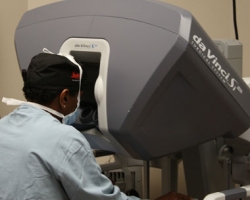Since late March, Sharp Chula Vista Medical Center has performed 36 surgeries using the Da Vinci Si HD surgical system, the only one of its kind in the South County.
For some time there has been the desire to have a robot in the surgery room, but it was not until the help of an anonymous donor through the Sharp HealthCare Foundation that the project moved forward, said Surgery Manager Daniel Cuellar.
“The robot helps with making delicate surgeries hands couldn’t do before,” Cuellar said.
For Enrique Sanchez, 71, of Chula Vista, robotic surgery was one of two options given to him to treat an aggressive case of prostate cancer.
“I was told robotic surgery was much cleaner and less invasive,” he said.
Sanchez was the first patient to undergo robotic surgery at Sharp Chula Vista Medical Center.
His operation had been scheduled to take place at a Sharp hospital in Grossmont, but the machine at the Chula Vista location was ready before the East County machine.
After the procedure, Sanchez said he had little pain after surgery and was out of the hospital in a couple of days.
Fast recovery is just one of the benefits from robotic surgery, said Dr. Julian Anthony, the urologist who operated on Sanchez using the Da Vinci robot.
The robotic surgical system makes small incisions rather than a big slice on the body, he said.
Arms in the console are small and delicate enough to go through small surgical holes and operate.
A camera is able to go through an incision and show a live three-dimensional HD view of where the surgery is being performed to the surgeon, said Dr. Julian Anthony.
Before the operation, the body is filled with carbon dioxide gas to fill up the stomach area and give organs plenty of space to facilitate surgery.
Other benefits include less blood loss and less transfusion rate and a less invasive surgery, Anthony said.
The roughly $2 million console has been used in the urology and gynecology departments, but may be used for heart surgery, pediatrics and gastric bypasses, Anthony said.
It is also FDA approved for thyroid surgery.
Cuellar said they are also planning on adding cardiac and general surgery using the robotic console.
Because the Da Vinci robot is more technology-dependent than other surgical methods, surgeons, nurses and scrub technicians must undergo a series of new training, Cuellar said.
Staff must meet certain criteria and depending on their position they undergo one, or more months of training.
“We’re ahead of the curve with others who have a robot,” Cuellar said.
Out-of-state surgeons have shown interest in moving to Chula Vista because of the robot, he said.
Like Cuellar, Anthony sees more robots in the future of medicine.
“Robotic surgery will be a larger part of my practice,” Anthony said.
Though many may fear going under the robotic needle, Cuellar said the best way to have confidence is to ask questions and be educated.
Sharp organizes seminars to answer people’s questions on robotic surgeries and other topics, he said.
Although the robot console is doing the cutting, the surgeon is still under control. There are three main components to the system.
The robot has a console the surgeon watches and uses his hands to guide the instruments and coordinate the robotic arms. They multitask using foot pedals and a tower which monitors and displays a larger screen with the surgery view.
Just like Cuellar advises, Sanchez previously attended seminars before his operation. He said he heard people talk about the procedure and learned more about what was going to happen to him.
“I’m naturally an easy-going person and I had confidence everything was going to go well,” he said.
As of today, Sanchez’ cancer is gone, though he will undergo future blood tests to monitor his health.

